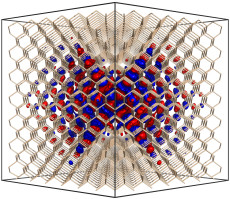
Isosurface enclosing 90 percent of the wave function for an in-gap state from a divacancy defect in silicon. Point defects in semiconductors are prototypes of solid-state qubits. This calculation cell contains 2,742 atoms and 10,968 electrons.
Mauro Del Ben of Lawrence Berkeley National Laboratory’s Computational Research Division and Charlene Yang of the National Energy Research Scientific Computing Center (NERSC) are lead authors on a paper that has been selected as a finalist for the ACM Gordon Bell Prize. The award, widely regarded as the Oscars of Supercomputing, recognizes outstanding achievements in HPC and especially in applying HPC technologies to solve challenging problems in science and engineering.
The paper, “Accelerating Large-Scale Excited-State GW Calculations on Leadership HPC Systems,” demonstrates for the first time the possibility of performing high-fidelity excited state calculations of complex materials at very large scales within minutes on current HPC systems, paving the way for future efficient HPC software development in materials, physical, chemical, and engineering sciences.
“In this paper, we present algorithm and implementation advancements made in the materials science code BerkeleyGW to scale calculations to over 10,000 electrons utilizing the entire Summit supercomputer at OLCF [Oak Ridge Leadership Computing Facility],” the researchers state in the abstract. “Excellent strong and weak scaling is observed, and a 105.9 PFLOP/s double-precision performance is achieved on 27,648 NVIDIA V100 GPUs, reaching 52.7 percent of the machine peak.” The parallelization and performance optimization techniques presented in this paper are widely applicable to other HPC applications and will be beneficial to the transition of 7,000 NERSC users to the Perlmutter supercomputer.
This work sets a new milestone for large-scale excited state electronic-structure calculations using the GW method and opens up new possibilities for high-fidelity complex materials science studies in the exascale timeframe, they added.
“What’s exciting about this accomplishment is that it ushers in the practical use of the high-fidelity GW method to the study excited states of realistic complex materials (with defects, interfaces, and large geometries) that drive real device design in quantum information, energy generation and storage, and next-generation electronics,” said Jack Deslippe, Application Performance Lead at NERSC and a co-author on the Gordon Bell finalist paper. “It’s incredible that we are able to get these results in a time to solution of minutes - not hours or days or weeks.”
The researchers will present their work at SC20 on Wed., Nov. 18, 4-4:30 pm EST. The winners will be announced on Thurs., Nov. 19 during the SC20 Awards Ceremony. Additional authors include Zhenglu Li and Steven Louie of the University of California at Berkeley and Berkeley Lab and Felipe da Jornada of Stanford University.
NERSC is a U.S. Department of Energy Office of Science User Facility.
About Computing Sciences at Berkeley Lab
High performance computing plays a critical role in scientific discovery. Researchers increasingly rely on advances in computer science, mathematics, computational science, data science, and large-scale computing and networking to increase our understanding of ourselves, our planet, and our universe. Berkeley Lab’s Computing Sciences Area researches, develops, and deploys new foundations, tools, and technologies to meet these needs and to advance research across a broad range of scientific disciplines.







 Instagram
Instagram YouTube
YouTube